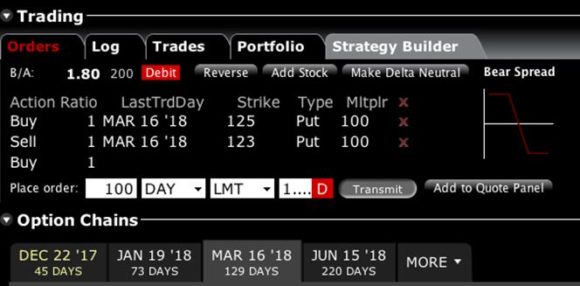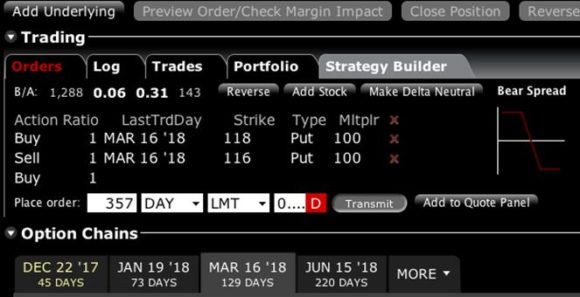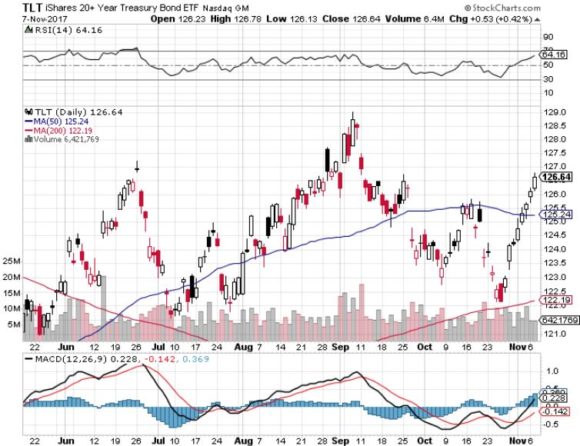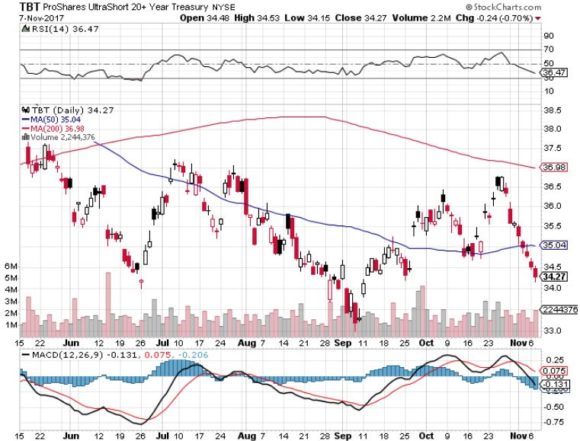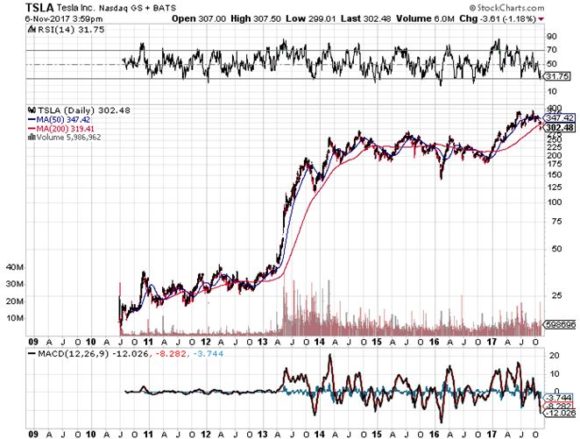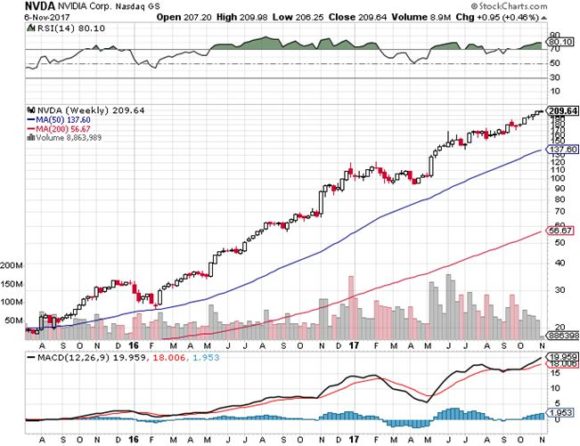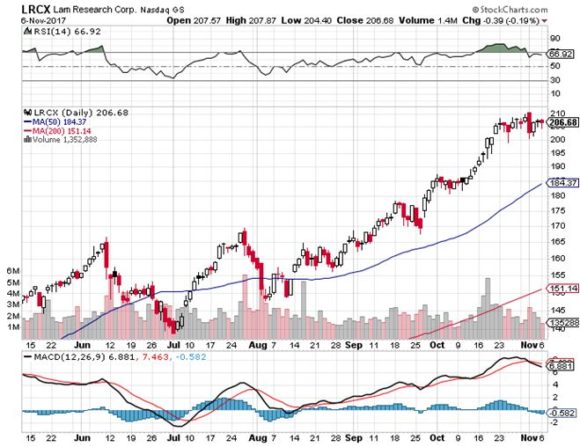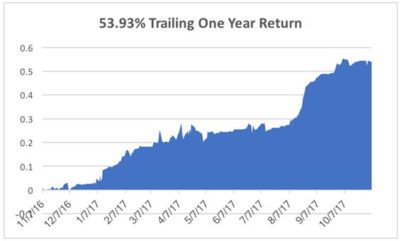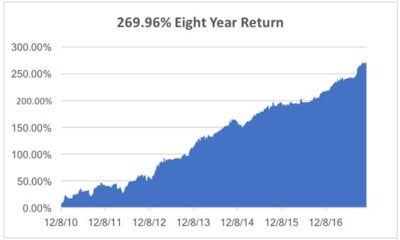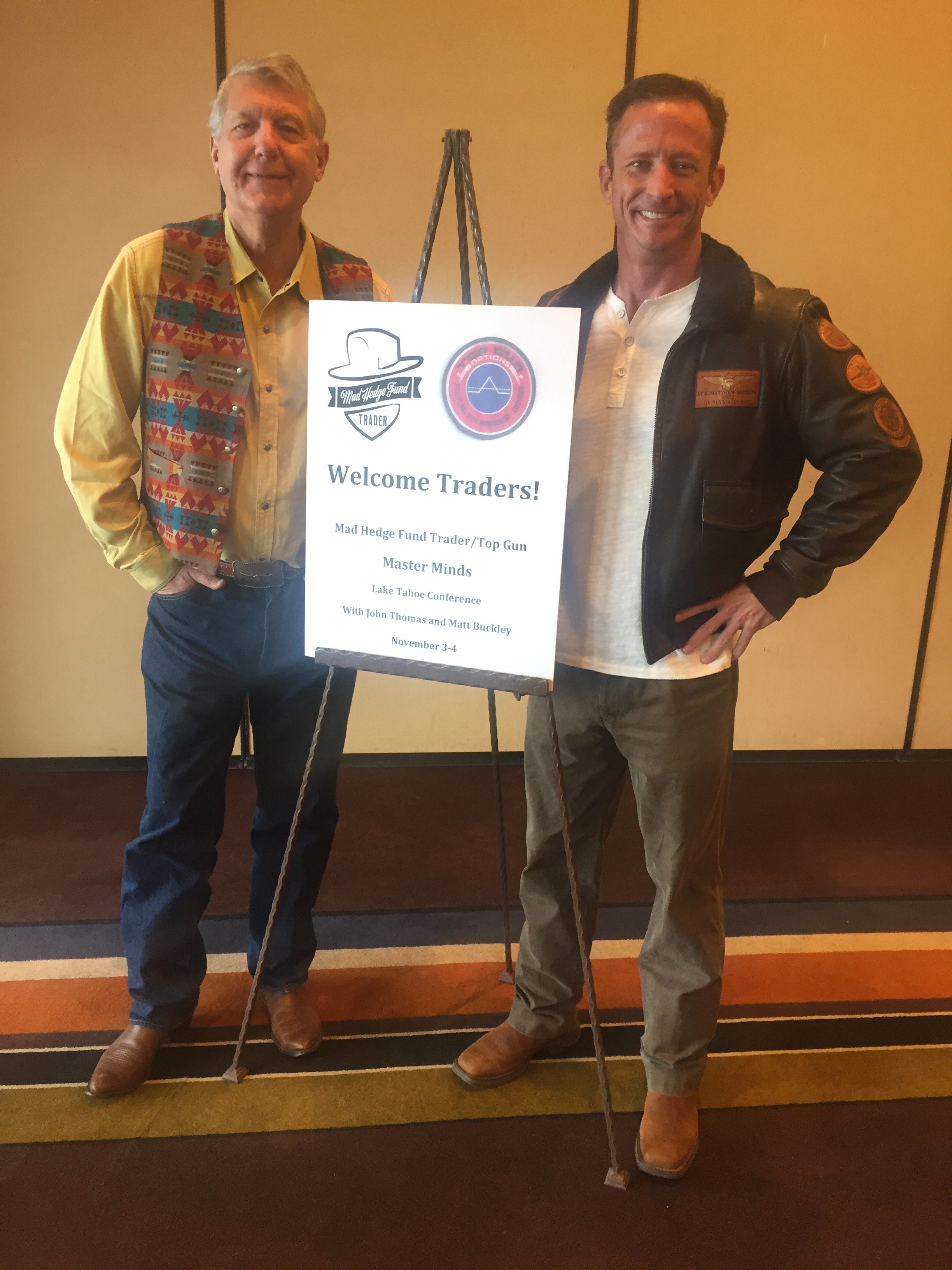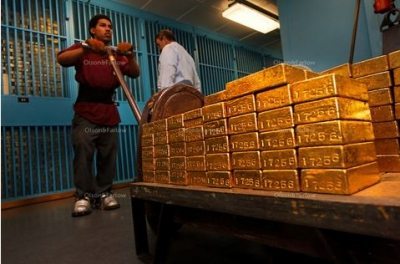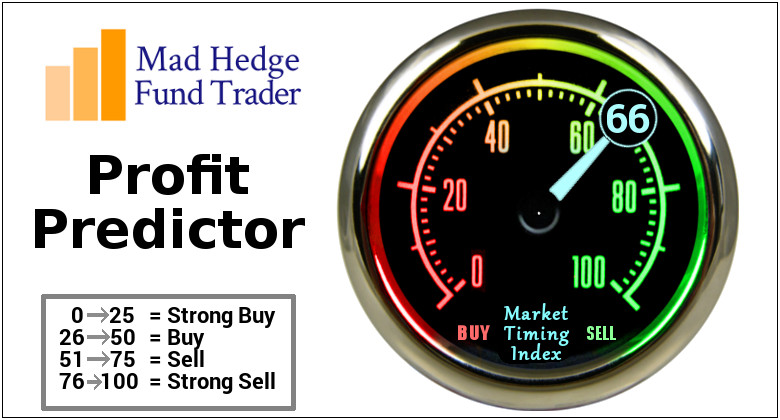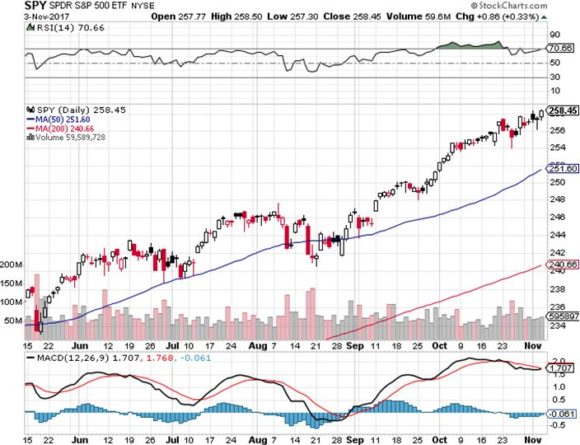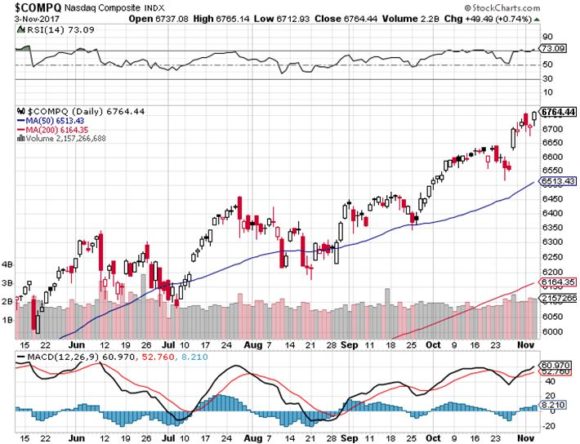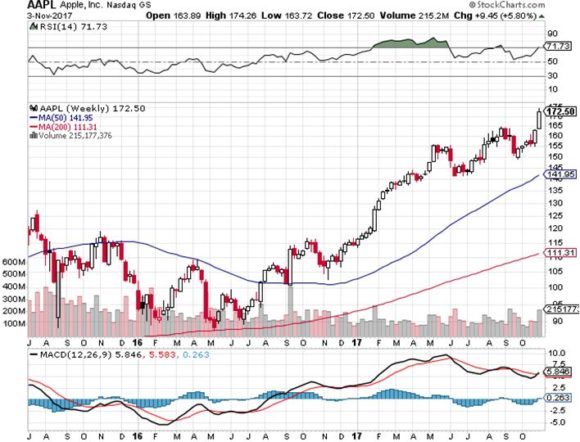
Global Market Comments
November 8, 2017
Fiat Lux
Featured Trade:
(BEHOLD THE POWER OF THE LEAP!),
(TLT), (TBT), ($TNX),
(EUROPEAN STYLE HOMELAND SECURITY),
(TESTIMONIAL)
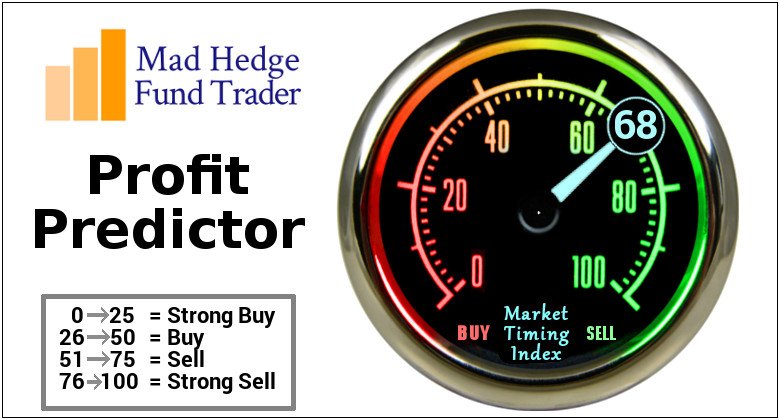
The recent 4 1/2 point jump in the US Treasury bond market has just given us another chance at the brass ring.
Except that this time, it's different.
Now we have a technical picture that is also setting up an almost perfect head and should top on the charts.
How would you like to get some free lottery tickets?
Except that these are better than lottery tickets.
Instead of a one in a million chance of winning some substantial dough, the odds of a big payoff are more like 90:10.
Have I piqued your interest? Are you ready to take a flier? Do you feel like rolling the dice?
And here's another come-on.
The last time I recommended this exact trade in August followers earned an eye-popping 50% return on capital in only four weeks!
It's really quite simple.
This morning, the yield on the ten-year Treasury bond briefly touched 2.29%, a new three month low.
Let's say that's the low for the year, and that yields rise from here for the next four months, pummeling the bond market.
This would be a fabulous time to buy a long dated (TLT) March 2018 $123-$125 out-of the-money vertical bear put spread at $1.00.
If bond yields back up to 2.45% where they were two weeks ago and shave five points off the (TLT) from today's levels, this spread would expire at its maximum theoretical value at $2.00 on March 16, 2018.
The profit on a $10,000 investment would amount to (100 contracts X 100 shares per option X $1.00), or $10,000, giving you a four-month gain of 100%.
Not bad in this yield deprived world.
Please see the screen shot from my Interactive Brokers platform to see how to set up this position.
Now let's say you have a prodigious appetite for risk and want to spend some of the massive profits you earned following the Diary of a Mad Hedge Fund Trader in recent months.
Let's say that you are willing to bet that bond yield are likely to back all the way up to the 2.62% where they traded in March.
In that case, you want to buy the (TLT) March 2018 $116-$118 deep out of-the-money vertical bear put spread at $0.28.
If you are correct, and bond yields back up to a lofty 2.62% and cut 11 points off the (TLT) from today's levels, this spread would expire at its maximum theoretical value of $2.00 on March 16, 2018.
The profit on a $10,000 investment would amount to (356 contracts X 100 shares per option X $1.72), or $61,232, giving you a four-month gain of 512.32%.
Please see the screen shot from my Interactive Brokers platform to see how to set up this much more aggressive high-risk position.
If you add either one of these super aggressive positions you are making a number of different bets.
1) The global synchronized economic recovery continues.
2) Jerome Powell, the next Fed governor, will continue with Janet Yellen's policy of raising interest rates 25 basis points per quarter.
3) Pernicious deflation moderates, thanks to the large scale recovery spending wrought by Hurricanes Harvey in Texas and Irma in Florida and the fires in Northern California.
4) Some kind of tax cut gets passed by congress within the next four months, no matter how modest.
These may not be bets that you are willing to make with your own hard earned cash.
But if they are, the potential payoff is enormous, a lot like winning the lottery.
I am not necessarily saying this is going to happen with any certainty.
Nevermind that every financial guru out there, including Warren Buffet, Ray Dalio, David Tepper, and George Soros agree with me and argue vociferously that bonds are wildly over priced, at a bubble top, and long overdue for a huge fall.
So far, they have all been wrong, including me.
I'm just sayin...

Here's the Brass Ring Trade for the Rest of 2017
The English are feeling the pinch in relation to recent geopolitical events, and have therefore raised their security level from "Miffed" to "Peeved."
Soon, though, security levels may be raised yet again to "Irritated" or even "A Bit Cross." The English have not been "A Bit Cross" since the blitz in 1940, when tea supplies nearly ran out.
Terrorists have been re-categorized from "Tiresome" to "A Bloody Nuisance." The last time the British issued a "Bloody Nuisance" warning level was in 1588, when threatened by the Spanish Armada.
The Scots have raised their threat level from "Pissed Off" to "Let's get the
Bastards." They don't have any other levels. This is the reason they have been used on the front line of the British army for the last 300 years.
The French government announced yesterday that it has raised its terror alert
level from "Run" to "Hide." The only two higher levels in France are "Collaborate" and "Surrender." The rise was precipitated by a recent fire that destroyed France's white flag factory, effectively paralyzing the country's military capability.
Italy has increased the alert level from "Shout Loudly and Excitedly" to
"Elaborate Military Posturing." Two more levels remain: "Ineffective Combat Operations" and "Change Sides."
The Germans have increased their alert state from "Disdainful Arrogance" to
"Dress in Uniform and Sing Marching Songs." They also have two higher levels: "Invade a Neighbor" and "Lose."
Belgians, on the other hand, are all on holiday, as usual; the only threat they
are worried about is NATO pulling out of Brussels.
The Spanish are all excited to see their new submarines ready to deploy. These beautifully designed subs have glass bottoms so the new Spanish navy can get a really good look at the old Spanish navy.
Australia, meanwhile, has raised its security level from "No worries" to
"She'll be alright, Mate." Two more escalation levels remain: "Crikey! I think we'll need to cancel the barbie this weekend!" and "The barbie is canceled." So far no situation has ever warranted use of the final escalation level.
-- John Cleese - British writer, actor and tall person.
Signing up for your service was the easiest decision that I have ever made knowing the value that I am getting in return. Thanks for making the world of capital markets profitable for non-Wall Street guys that are busy working in other professions.
Until now, I have been forced to deal with money managers or "Company Men" that only push the products their higher ups want to sell. Finally, I have an alternative route to go.
Thanks a "Million."
Jim
Northbrook, IL
Global Market Comments
November 7, 2017
Fiat Lux
Featured Trade:
(LAKE TAHOE CONFERENCE REVIEW),
(HOW TO MAKE MORE MONEY THAN I DO),
(ABX), (AAPL), (TSLA), (NVDA)

It's tough to pick the highpoint of the Mad Hedge/Top Gun Masterminds Lake Tahoe Conference last weekend.
Maybe it was opening the second case of Caymus, the best cabernet produced in California.
Perhaps it was the herd of wild mustangs we drove past on the way from Reno/Tahoe airport.
Or possibly it was my third helping of filet mignon at the Friday night VIP dinner.
No, it was none of these.
Undoubtable, it was the guest who told me she parlayed $5,000 into $2 million over the past nine years, solely on the back of my Trade Alerts.
Among her big wins were buying Apple (AAPL) stock at $20, Tesla (TSLA) at $17, and an NVIDIA (NVDA) one year options leap that delivered a staggering 800% return.
To top it all, she picked up semiconductor equipment maker Lam Research (LRCX) right before its recent 50% move.
What's she eyeing now?
A new position in Intel (INTC).
Maybe I should turn over all my money for her to manage?
Of course, all you had to do to justify the trip was to walk outside and take a look at the scenery.
The High Sierras were topped with last night's snow fall down to 7,000 feet.
A stiff wind roiled and churned the sapphire blue lake.
Flocks of Canadian geese flew back and forth in front of the dramatic backdrop.
In case I bored the guests with my pontifications, they simply had to fixate on the wetsuit protected windsurfer racing across the wave tops right behind me.
Brad Barnes from Entruity Wealth Management informed the room with a presentation on "Fact Based Investing".
Top Gun's Matthew Buckly riveted the viewers with recollections of flying an F-18 Hornet for the Navy, and how to apply military disciplines and strategies to successful trading.
I did my best to hold the audience with two presentations on "The Field Guide to Market Tops" and "The Financial System in 2030."
If I suspected someone was nodding off from the Caymus, I simply opened the door a notch to allow a blast of cold air to issue a wakeup call.
The event was more than just an educational exercise on the short and long term future of the markets.
Guests also exchanged notes on how to best take advantage of my Trade Alerts.
It's clear than many are making a multiple of my reported performance.
Some of the ideas I head were utterly amazing. To learn more, please read "How to Make More Money Than I Do" below.
The forum was also a celebration of a decade of successful trading with the Diary of a Mad Hedge Fund Trader.
I heard tales of home mortgages and student loans paid off, the acquisition of new toys galore, chemotherapy treatments financed for uncovered family members, and financial security for life.
One even told me he loved Lake Tahoe so much that he was planning to move here from the East Coast, and had even applied for a position as a ski instructor at a local resort!
Needless to say, we'll be hosting another Lake Tahoe Conference in a year that will be bigger and better. Almost everyone who came this year plans to return.
I'll see you then.
John Thomas
CEO and Publisher
The Diary of a Mad Hedge Fund Trader
By now, most of you have figured out that I love calling readers every day and milking them for ideas on how to improve my service.
Often they think I am an imposter, a telephone salesman, a machine, or an algorithm. It's only after listening for a few seconds that they recognize my voice from the biweekly strategy webinars and realize that it's the real me.
I don't do this to get renewals, because everyone renews anyway. Where else do you get a 62% annual return with no serious drawdowns?
No, I do it because the information I pick up from subscribers is golden. Some of my best Trade Alerts are inspired by reader questions.
One of my favorite Einstein quotes is that "There are no stupid questions, only stupid answers."
In fact, I have discovered that a lot of subscribers are making much more money from my service than I do.
I'll tell you how they do it.
First, let me remind readers that every Trade Alert I send out includes recommendation for a call or put option spread, a single stock, or an ETF.
The trading performance charts that we published are based on the options spread positions only.
1) Raise the Strike Prices
Move the strike prices up by a dollar. So instead of buying the Barrick Gold (ABX) September $15-$16 deep in-the-money vertical bull call spread, you pick up the $16-$17 call spread instead.
Generally you make a profit that is 50% greater on this higher spread than with the original recommendation. But you are also taking on higher risk.
When 90% or more of our Trade Alerts are successful (the hit rate has been 100% for the past three months), this has been a pretty good bet to make.
2) Buy the Call Options Only
Instead of buying the call spread, you buy the call option only in half the size.
When it works, your upside is unlimited. When it doesn't, you just write off the total value of your investment.
This is a great approach when the stocks I recommend take off like a rocket and double or more, as have Apple (AAPL), Tesla (TSLA), and NVIDIA (NVDA).
Option spread buyers leave a lot of money on the table with this scenario, but get lower performance volatility.
I have observed that many of my Australia readers pursue this approach, as they are fighting a 14-hour time zone disadvantage with the New York Stock Exchange. Not many want to trade at 4:00 AM.
The payoff is that they earn about double what I do trading the same stocks.
3) Buy a 2X or 3X Leveraged ETF
This is moving out even further off the risk curve.
Almost every one of the 101 S&P 500 sectors have listed for them 2X and 3X bull and bear ETF's. In theory, the best-case scenario for one of these funds is that they will rise three times as fast as the underlying basket.
In theory, I said.
By the time you take out management fees, tracking error, and execution costs, and wide spreads, you are more likely to get 2.5 times the basket appreciation, if not 2 X.
I normally steer investors away from 3X funds. But 401k traders, who are not allowed to deal in stock options, swear by them.
4) Trade Futures
This is a favorite of foreign exchange, precious metals, and bond traders. A futures contract can deliver up to 100 times the performance of the underlying currency, metal, or Treasury bond.
Get a good entry point, run a tight stop loss, and the potential gains can be astronomical.
Every year we get a couple of followers who earn 1,000% profits using our market timing for entry and exit point, and they always do it through the futures markets. Yes, that is a 10X return.
This is also a much higher risk, but higher return strategy. Your broker will present greater disclosure requirements and need a higher clearance level.
But potentially retiring in a year is ample bait for many professionals to go through with his.
5) Read the Research
I know a lot of you only buy this service only for our industry beating Trade Alert service.
But my decade long experience in watching readers succeed, or fail, in their executions is that the more research they read, the more money they make.
Don't try to skim though with a minimal effort.
It's really very simple. The more work you put into this, the more profit you take out.
Understanding fully what is happening in the markets, indeed the entire global economy, will give you the confidence you need to take on bigger positions and make A LOT more money.
There is no free lunch. There is no Holy Grail.
Having said all that, good luck and good trading.
Looks Like I Got Another One
When asked about the urban legend that the vaults at Fort Knox are empty, and that the Fed has no gold, former Federal Reserve Chairman Ben Bernanke responded,"I've been to the basement of the New York Fed. The gold is there. I've seen it."
Global Market Comments
November 6, 2017
Fiat Lux
Featured Trade:
(MARKET OUTLOOK FOR THE WEEK AHEAD, OR
WHAT A WEEK THAT WAS!), (AAPL),
(DON'T GET SCAMMED BY THE MUTUAL FUNDS)
What a week that was!
Trump campaign criminal indictments, a controversial new tax bill, Apple earnings, a Fed governor appointment, and a blockbuster Nonfarm payroll report would have kept the hands full of any trader.
Yet, despite all of this, markets closed at new all-time highs on Friday.
Followers of the Mad Hedge Fund Trader also got to enjoy the Lake Tahoe Master Minds Conference on the weekend, one of the truly insightful events of the year.
But more on that another day.
I'll make a few brief comments on the the week's action, as I have to race over a High Sierra mountain pass before it is closed by snow.
The Big MO continues.
The market momentum is so overwhelming that to resist it would be like standing in front of a runaway locomotive.
Hedge funds have lost half their potential trades, the short side, and are getting hit with massive redemptions for poor performance.
All agree that it will end, and maybe soon, but NO ONE is willing to stick there neck out now.
As for me, I am committing to going 100% into cash in mid-December, now the de facto end of the year.
The risk/reward of initiating new positions is now so unfavorable, that no other choice is justified.
With mountains of tax deferred selling postponed until 2018, January has HURT written all over it.
Some 100% of the market gains in October were due to only the five FANG stocks.
Without their contribution, the S&P 500 would have been down for the month.
Talk about concentration!
Apple (AAPL) alone added $80 billion in market capitalization, the equivalent of the GDP of a small country, larger than Ethiopia, but smaller than Sri Lanka.
Apple earnings came out better than expected, pouring more fuel on the FANG fire, taking the share up 53.51% since January, creating an eye-popping $310 billion in new market capitalization.
The Federal Open Market Committee came and went with no action, as expected. The federal funds rate stands at a 1.25%-1.50% range.
Don't expect the same at the December meeting.
From January, the meeting will be held with a new boss in town.
Jerome Powell was the closest thing to an ultra-dove the Republicans could find in their party.
So expect Janet Yellen's policies will continue unchanged, with a focus on jobs, and interest rates lower for longer.
You don't want to appoint an interest rate hawk to the Fed just before you take on a mountain of new debt, which seems to be the plan.
Mueller fired the opening salvo in a long string of criminal indictments that will stretch out for years.
His strategy is clearly to arrest peripheral figures first, squeeze them for all they're worth to exchange damning testimony for a light plea bargain, then circle in on the final criminal mastermind, whoever that may be.
The markets proved how desensitized they have become to out-of-the-blue Washington shockers by engineering a mere 200 point correction, which was over in hours.
The FBI has been doing this for 100 years. It is all classic G-Man stuff. Expect it to continue.
What better way to finish the week than with a blockbuster October Nonfarm Payroll Report that showed the economy added 261,000 jobs.
The headline Unemployment Rate collapsed to a subterranean 4.1%.
It shows that the hurricane inspired dent to the economy snapped back smartly, as I expected.
A global synchronized economic recovery is a tough thing to bet against.
What is happening now is that Europe and Japan, once a drag on growth, are now beating the pants off the US.
That's because they implemented American style quantitative easing five year later, and it is only now starting to bear fruit.
As for the tax bill, don't even waste your time reading about it nor your accountant's.
There is absolutely NO chance that the bill will pass in the remaining eight working days congress still has in 2017.
The president believes as much by leaving the country for 14 days the day the plan was announced.
If he thought the bill had the remotest chance of passing he would be here working the phones like crazy trying to force it through.
Something greatly diluted will get through some time next year with minimal impact on the economy, but with a lot of new government debt.
The economy, and corporate America, are doing just fine, thank you, as this year's earnings reports confirm.
So don't downgrade your car, sell off the second home, or tell the kids they need to get minimum wage jobs to finish college just yet.
The coming week will be the slowest of the month from a data point of view.
On Monday, November 6, there is no economic data of any import.
On Tuesday, November 7 at 6:00 AM EST we get a new NFIB Small Business Optimism Index, which is based on a questionnaire of only 10 common business outlook questions.
On Wednesday, November 8, at 7:00 AM EST we obtain MBA Mortgage Applications, which should tail off, given the recent sharp rise in interest rates.
The weekly EIA Petroleum Status Report is out at 10:30 AM.
Thursday, November 9 at 8:30 AM EST we learn the Weekly Jobless Claims, which have been plunging to new 43 year lows.
On Friday, November 10 at 1:00 PM, we receive the Baker-Hughes Rig Count, which lately has been rolling over.

